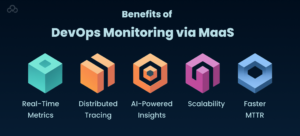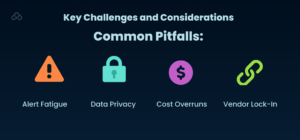Monitoring used to be something teams thought about after things broke. But in the world of modern cloud applications, where systems are dynamic, distributed, and constantly evolving, that approach just doesn’t cut it anymore.
As infrastructures scale across Kubernetes, multi-cloud, and microservices, the margin for error shrinks. Without clear visibility into what’s happening under the hood, issues slip by unnoticed, until they explode into outages or customer complaints.
This is where Monitoring as a Service (MaaS) comes in.
Rather than stitching together logs, metrics, and dashboards on your own, MaaS delivers a ready-to-use solution for full-stack observability. It integrates directly with your DevOps platform, automates visibility, and scales with your stack. For any DevOps services company helping clients streamline operations, MaaS is no longer just an option, it’s a core requirement.
And in today’s era of continuous deployment and short feedback loops, MaaS doesn’t just support DevOps. It makes it possible. That’s why it’s now a go-to strategy in cloud-native DevOps development, offering faster detection, clearer insight, and better outcomes across the board.
What is Monitoring as a Service (MaaS)?
Monitoring as a Service (MaaS) is a cloud-delivered model for observability. Instead of installing on-premise tools and scaling them manually, you subscribe to a cloud-based monitoring platform that handles metrics, logs, traces, and alerts across your environments.
In the context of DevOps cloud computing for a DevOps services company, MaaS offers visibility into both infrastructure and application layers. Unlike traditional monitoring, which often required complex setup and maintenance, MaaS is designed to be agile, lightweight, and DevOps-ready.
Core Components of MaaS:
- Agents or SDKs embedded into services to collect telemetry data
- Data pipelines to process logs, metrics, and traces in real time
- Dashboards for visualization and alerting
- Integrations with CI/CD tools and cloud platforms
Example: A DevOps development company migrated from Nagios to Grafana Cloud, reducing their monitoring setup time by 60%.
Whether you’re a startup or an enterprise, MaaS scales with you, offering real-time observability without compromising performance.
Benefits of DevOps Monitoring via MaaS

Why is MaaS gaining traction among DevOps teams? Because the benefits go far beyond convenience. When managed well by a skilled DevOps services company, MaaS becomes a strategic advantage.
Key Benefits:
– Real-Time Metrics: Capture and react to performance issues as they happen.
– Distributed Tracing: Follow requests across microservices for root cause analysis.
– AI-Powered Insights: Detect anomalies before they affect users.
– Scalability: Adapt monitoring to growing workloads automatically.
– Faster MTTR (Mean Time to Resolution): Reduce downtime with rapid alerting and diagnostics.
According to 2024 DevOps Pulse data, over 78% of organizations rely on cloud-based observability platforms like Datadog or Prometheus.
In today’s fast-moving release cycles, the benefits of DevOps depend heavily on proactive monitoring. MaaS delivers that without overburdening internal teams.
How DevOps Services Companies Use MaaS
A DevOps services company brings expertise in integrating MaaS into your CI/CD and cloud workflows. They ensure monitoring isn’t just bolted on, it’s embedded from the start.
Common Use Cases:
– Centralized Logging: Unify logs across Kubernetes clusters and cloud platforms.
– Metric Aggregation: Aggregate and visualize custom metrics per service, per deployment.
– Multi-Cloud Visibility: Monitor AWS, Azure, and GCP environments under one roof.
– API-Driven Dashboards: Generate custom insights for SREs, devs, and security teams.
Case Study: A logistics firm partnered with a DevOps development company to deploy New Relic for MaaS. The result? 42% reduction in downtime and 3x faster incident resolution.
With the right partner, MaaS becomes more than a tool, it becomes a foundation of your DevOps platform.
Popular Tools in DevOps Cloud Computing MaaS
Choosing the right tool depends on your stack, team size, and observability goals. Most DevOps services companies work across multiple platforms.
|
Tool |
Capabilities |
|
Datadog |
Full-stack monitoring, AI alerts, cloud-native integration |
|
Prometheus |
Time-series metrics, Kubernetes-native, open-source |
|
Grafana Cloud |
Dashboards, alerting, logs, traces, plugins |
|
New Relic |
App monitoring, custom instrumentation, APM |
|
Dynatrace |
AI ops, user sessions, smart root cause analysis |
|
AWS CloudWatch |
Native to AWS, good for infra metrics and logging |
Each platform has pros and cons, working with a DevOps development company can help map the right tool to your needs.
Technical FAQs
Q1: How does MaaS differ from traditional monitoring in a DevOps platform?
Traditional monitoring is infrastructure-heavy and lacks flexibility. MaaS offers real-time, cloud-native observability that integrates with modern DevOps workflows and scales automatically.
Q2: Can MaaS be integrated with existing CI/CD pipelines?
Yes. Most MaaS platforms offer webhooks, APIs, or plugins to plug into your deployment pipeline, enabling alerts, dashboards, and rollback triggers tied to releases.
Q3: What security considerations should DevOps teams account for with MaaS?
Look for encryption at rest/in transit, role-based access controls, and audit trails. A good DevOps services company will help configure secure, compliant observability setups.
Q4: How does a DevOps services company typically manage MaaS for clients?
They handle tool selection, configuration, alert tuning, dashboarding, and ongoing optimization, aligning MaaS output with SLOs, SLAs, and incident response needs.
Q5: Does MaaS offer predictive or AI-driven insights?
Many platforms now include anomaly detection, predictive scaling, and proactive alert suppression, all useful features in a modern DevOps cloud computing environment.
Key Challenges and Considerations

Despite its benefits, MaaS isn’t plug-and-play. Without proper design, it can overwhelm teams or blow budgets.
Common Pitfalls:
– Alert Fatigue: Too many alerts from poorly tuned thresholds.
– Data Privacy: Inadequate masking or access control in regulated environments.
– Cost Overruns: High data ingestion and retention fees for verbose logs or metrics.
– Vendor Lock-In: Proprietary platforms make it hard to migrate later.
Working with a reputable DevOps services company helps avoid these traps by aligning tools to both business needs and compliance requirements.
Future Trends in MaaS and DevOps Platforms
Monitoring as a Service (MaaS) isn’t standing still. It’s evolving rapidly to meet the demands of distributed architectures, real-time deployments, and AI-powered infrastructure. As systems grow more complex, monitoring must evolve from reactive dashboards to predictive, self-healing platforms, deeply embedded into every layer of the DevOps platform for each DevOps services company.
Here’s what’s shaping the future of MaaS and how forward-thinking DevOps development companies are preparing:
What’s Next:
1. AI Ops
Expect systems that don’t just detect anomalies, but auto-remediate them, adjusting configurations, throttling traffic, or restarting services based on learned behavior. This shift from reactive alerts to proactive resolution reduces the burden on operations teams and slashes downtime.
2. Unified Observability
No more siloed data. The next-gen MaaS platforms are bringing together logs, metrics, traces, and even end-user behavior into a single, searchable pane of glass. It’s not just about visibility, it’s about connecting the dots across your entire cloud stack.
3. Service Mesh Integration
As Istio, Linkerd, and Envoy continue to power modern service-to-service communication, MaaS platforms are evolving to natively support mesh observability. This means richer telemetry, real-time policy enforcement, and better insights into east-west traffic patterns.
4. DevOps-First Design
MaaS is no longer an afterthought. New tools are built from the ground up with DevOps cloud computing in mind, automated provisioning, CI/CD integration, and environment-aware metrics built in. Leading DevOps services companies are already baking MaaS directly into their platform offerings for clients.
Bottom line: The MaaS of tomorrow won’t just watch. It will act, adjust, and protect, automatically.
Observability as a DevOps Superpower
At the heart of effective DevOps is one thing: visibility. Without it, speed turns into recklessness, and scaling leads to chaos. That’s why Monitoring as a Service (MaaS) has become more than just a tool, it’s a safeguard for innovation.
For teams working across cloud environments, containers, and fast-paced deployment cycles, MaaS delivers what spreadsheets and legacy systems can’t: real-time awareness, proactive alerting, and intelligent insights built for modern systems.
Therefore, When paired with a trusted DevOps services company, MaaS evolves from a monitoring solution into an operational cornerstone. You gain the ability to respond faster, recover sooner, and improve continuously, all without adding complexity to your stack.
And that’s the real benefit of DevOps: building and releasing software with confidence, knowing that if something does go wrong, you’ll see it first, and fix it fast.
With the right DevOps platform in place and MaaS integrated from the start, teams move beyond reactive firefighting and into a space where delivery is fast, stable, and sustainable.
Because in DevOps, what you don’t monitor can hurt you. And what you do monitor? That’s where your power lies.
Do you like to read more educational content? Read our blogs at Cloudastra Technologies or contact us for business enquiry at Cloudastra Contact Us